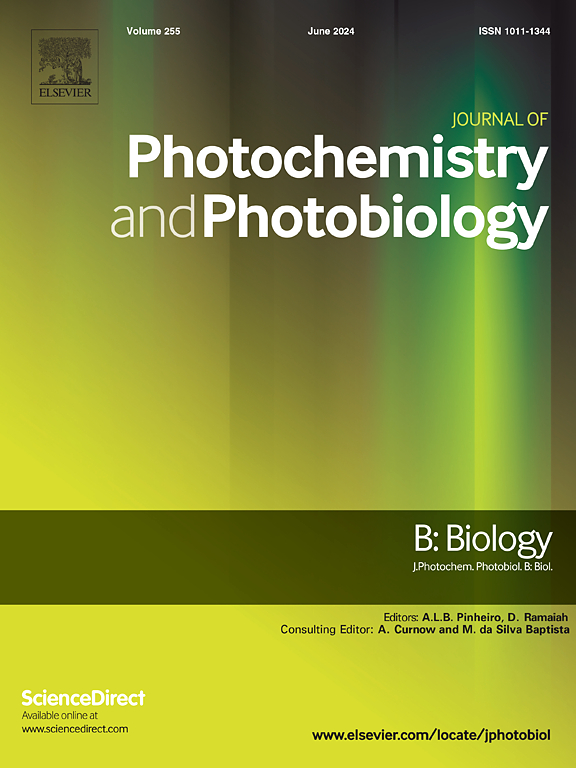光动力疗法与免疫疗法相结合可增强抗癌疗效。
IF 3.9
2区 生物学
Q2 BIOCHEMISTRY & MOLECULAR BIOLOGY
Journal of photochemistry and photobiology. B, Biology
Pub Date : 2024-10-28
DOI:10.1016/j.jphotobiol.2024.113048
引用次数: 0
摘要
众所周知,光动力疗法(PDT)可诱发免疫性细胞死亡(ICD),甚至在未经治疗的转移性癌症中也能产生抗癌效果,这种现象被称为 "缺席效应"。此外,ICD诱导可激活免疫反应,从而与免疫疗法产生协同作用。我们的研究目的是评估光动力疗法与免疫疗法相结合的抗癌效果。为了评估体内抗癌疗效和腹水效应,我们将 CT26 细胞植入 BALB/c 小鼠的两侧腹部。小鼠被分为五组:1)PBS;2)单独免疫治疗;3)单独PDT;4)PDT三天后免疫治疗;5)PDT后立即免疫治疗。在原发肿瘤上观察到的抗肿瘤效果依次为:PDT 后立即使用免疫疗法 > PDT 3 天后使用免疫疗法 > 单独使用 PDT > 单独使用免疫疗法 > PBS。在未直接治疗的转移性肿瘤中,PDT 后立即进行免疫治疗的效果也最好。总之,我们的研究证实,光动力疗法与免疫疗法相结合可提高对原发性和转移性肿瘤的抗癌疗效。此外,在光动力疗法后立即使用免疫疗法比延迟使用更有效。本文章由计算机程序翻译,如有差异,请以英文原文为准。
Enhanced anticancer efficacy of photodynamic therapy in combination with immunotherapy
Photodynamic therapy (PDT) is known to trigger immunogenic cell death (ICD), leading to an anticancer effect even in untreated metastatic cancer, a phenomenon called the “abscopal effect”. Furthermore, ICD induction activates an immune response, which may synergize with immunotherapy. The objective of our research was to evaluate the anticancer efficacy of combining PDT with immunotherapy. To assess in vivo anticancer efficacy and the abscopal effect, we implanted CT26 cells on both flanks of BALB/c mice. The mice were categorized into five different groups: 1) PBS, 2) immunotherapy alone, 3) PDT alone, 4) immunotherapy administered 3 days after PDT, and 5) immunotherapy administered immediately after PDT. The observed antitumor effects on the primary tumor followed this order: immunotherapy administered immediately after PDT > immunotherapy administered 3 days after PDT > PDT alone > immunotherapy alone > PBS. In metastatic tumors that were not directly treated, immunotherapy administered immediately after PDT was also the most effective. In conclusion, our study confirms that the combination of PDT with immunotherapy enhances anticancer efficacy against both primary and metastatic tumors. Additionally, administering immunotherapy immediately after PDT is more effective than delayed administration.
求助全文
通过发布文献求助,成功后即可免费获取论文全文。
去求助
来源期刊
CiteScore
12.10
自引率
1.90%
发文量
161
审稿时长
37 days
期刊介绍:
The Journal of Photochemistry and Photobiology B: Biology provides a forum for the publication of papers relating to the various aspects of photobiology, as well as a means for communication in this multidisciplinary field.
The scope includes:
- Bioluminescence
- Chronobiology
- DNA repair
- Environmental photobiology
- Nanotechnology in photobiology
- Photocarcinogenesis
- Photochemistry of biomolecules
- Photodynamic therapy
- Photomedicine
- Photomorphogenesis
- Photomovement
- Photoreception
- Photosensitization
- Photosynthesis
- Phototechnology
- Spectroscopy of biological systems
- UV and visible radiation effects and vision.

 求助内容:
求助内容: 应助结果提醒方式:
应助结果提醒方式:


